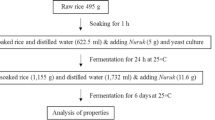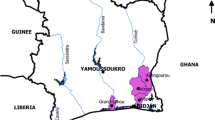Abstract
The setting up of new molecular methods for Saccharomyces cerevisiae typing is valuable in enology. Actually, the ability to discriminate different strains in wine making can have a benefit both for the control of the fermentation process and for the preservation of wine typicity. This study focused on the screening of single-nucleotide polymorphisms in genes involved in wine production that could evolve rapidly considering the selective pressure of the isolation environment. Preliminary screening of 30 genes in silico was performed, followed by the selection of 10 loci belonging to 8 genes. The sequence analysis showed a low polymorphism and a degree of heterozygosity. However, a new potential molecular target was recognized in the TPS1 gene coding for the trehalose-6-phosphate synthase enzyme involved in the ethanol resistance mechanism. This gene showed a 1.42% sequence diversity with seven different nucleotide substitutions. Moreover, classic techniques were applied to a collection of 50 S. cerevisiae isolates, mostly with enologic origin. Our results confirmed that the wine making was not carried out only by the inoculated commercial starter because indigenous strains of S. cerevisiae present during fermentation were detected. In addition, a high genetic relationship among some commercial cultures was found, highlighting imprecision or fraudulent practices by starter manufacturers.

Similar content being viewed by others
References
Aa E, Townsend JP, Adams RI, Nielsen KM, Taylor JW (2006) Population structure and gene evolution in Saccharomyces cerevisiae. FEMS Yeast Res 6:702–715
Ayoub MJ, Legras JL, Saliba R, Gaillardin C (2006) Application of multilocus sequence typing to the analysis of the biodiversity of indigenous Saccharomyces cerevisiae wine yeasts from Lebanon. J Appl Microbiol 100:699–711
Ben-Ari G, Zenvirth D, Sherman A, Simchen G, Lavi U, Hillel J (2005) Application of SNPs for assessing biodiversity and phylogeny among yeast strains. Heredity 95:493–501
Cai S, Kabuki DY, Kuaye AY, Cargioli TG, Chung MS, Nielsen R, Wiedmann M (2002) Rational design of DNA sequence-based strategies for subtyping Listeria monocytogenes. J Clin Microbiol 40:3319–3325
Capece A, Salzano G, Romano P (2003) Molecular typing techniques as a tool to differentiate non-Saccharomyces wine species. Int J Food Microbiol 84:33–39
Clarke SC (2002) Nucleotide sequence-based typing of bacteria and the impact of automation. Bioessay 24:858–862
Cliften P, Sudarsanam P, Desikan A, Fulton L, Fulton B, Majors J, Waterston R, Cohen BA, Johnston M (2003) Finding functional features in Saccharomyces genomes by phylogenetic footprinting. Science 301:71–76
Cocolin L, Bisson LF, Mills DA (2000) Direct profiling of the yeast dynamics in wine fermentation. FEMS Microbiol Lett 189:81–87
Comi G, Maifreni M, Manzano M, Lagazio C, Cocolin L (2000) Mitochondrial DNA restriction enzyme analysis and evaluation of the enological characteristics of Saccharomyces cerevisiae strain isolated from grapes of the wine-producing area of Collio (Italy). Int J Food Microbiol 58:117–121
de Las Rivas B, Marcobal A, Muñoz R (2004) Allelic diversity and population structure in Oenococcus oeni as determined from sequence analysis of housekeeping genes. Appl Environ Microbiol 70:7210–7219
Enright MC, Spratt BG (1999) Multilocus sequence typing. Trends in Microbiol 7:482–487
Fernándes-Espinar MT, Lopez V, Ramon D, Bartra E, Querol A (2001) Study of the authenticity of commercial wine strains by molecular techniques. Int J Food Microbiol 70:1–10
Fleet GH (1997) Wine. In: Doyle MP, Beuchat LR, Montville T (eds) Food microbiology fundamentals and frontiers. American Society for Microbiology, Washington DC, pp 671–696
Heard G (1999) Novel yeasts in winemaking-looking to the future. Food Aust 51:347–352
Jubany S, Tomasco I, Ponce de León I, Medina K, Carrau F, Arrambide N, Naya H, Gaggero C (2008) Toward a global database for the molecular typing of Saccharomyces cerevisiae strains. FEMS Yeast Res 8:472–484
Kellis M, Patterson N, Endrizzi M, Birren B, Lander ES (2003) Sequencing and comparison of yeast species to identify genes and regulatory elements. Nature 423:241–254
Lucero P, Peñalver E, Moreno E, Lagunas R (2000) Internal trhalose protects endocytosis from inhibition by ethanol in Saccharomyces cerevisiae. Appl Environ Microbiol 66:4456–4461
Merico A, Capitanio D, Vigentini I, Ranzi BM, Compagno C (2003) Aerobic sugar metabolism in the spoilage yeast Zygosaccharomyces bailii. FEMS Yeast Res 4:277–283
Miot-Sertier C, Lonvaud-Funel A (2007) Development of a molecular method for the typing of Brettanomyces bruxellensis (Dekkera bruxellensis) at the strain level. J Appl Microbiol 102:555–562
Ness F, Lavallée F, Dubourdieu D, Aigle M, Dulau L (1993) Identification of yeast using the polymerase chain reaction. J Sci Food Agric 62:89–94
Pretorius IS (2000) Tailoring wine yeast for the new millennium: novel approaches to the ancient art of wine making. Yeast 16:675–729
Querol A, Barrio E, Huerta T, Ramón D (1992) Molecular monitoring of wine fermentation conducted by active dry yeast system. Appl Environ Microbiol 58:2948–2953
Tavanti A, Davidson AD, Fordyce MJ, Gow NAR, Maiden MCJ, Odds FC (2005) Population structure and properties of Candida albicans, as determined by multilocus sequence typing. J Clin Microbiol 43:5601–5613
Acknowledgment
We are grateful to the wineries registered at “Consorzio per la tutela del Franciacorta DOCG” that collaborated in this study.
Author information
Authors and Affiliations
Corresponding author
Rights and permissions
About this article
Cite this article
Vigentini, I., Fracassetti, D., Picozzi, C. et al. Polymorphisms of Saccharomyces cerevisiae Genes Involved in Wine Production. Curr Microbiol 58, 211–218 (2009). https://doi.org/10.1007/s00284-008-9310-x
Received:
Revised:
Accepted:
Published:
Issue Date:
DOI: https://doi.org/10.1007/s00284-008-9310-x




